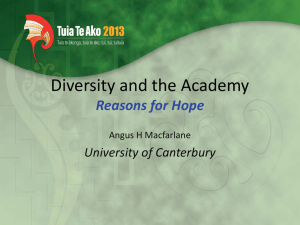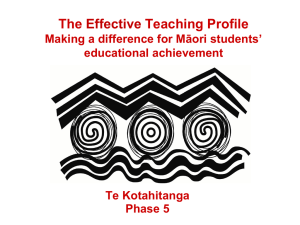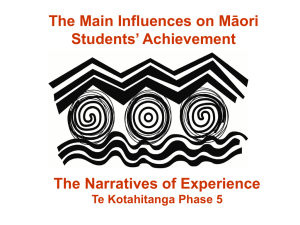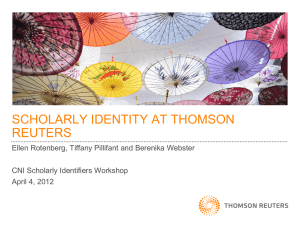guidance in preparing the statement
advertisement
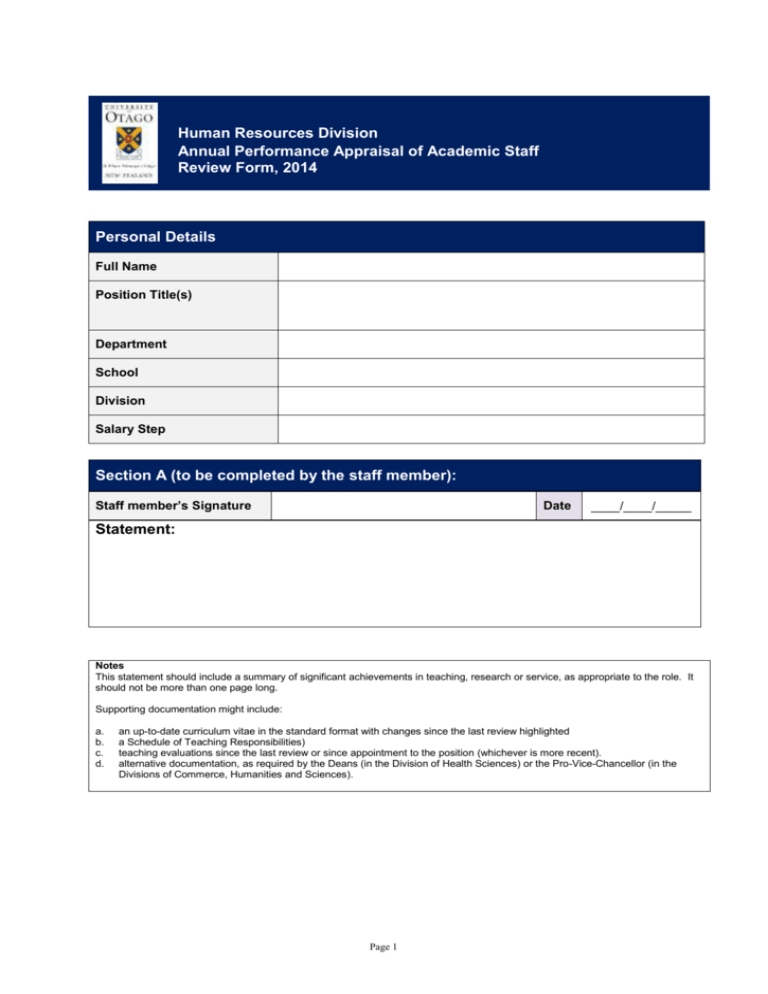
Human Resources Division Annual Performance Appraisal of Academic Staff Review Form, 2014 Personal Details Full Name Position Title(s) Department School Division Salary Step Section A (to be completed by the staff member): Staff member’s Signature Date ____/____/_____ Statement: Notes This statement should include a summary of significant achievements in teaching, research or service, as appropriate to the role. It should not be more than one page long. Supporting documentation might include: a. b. c. d. an up-to-date curriculum vitae in the standard format with changes since the last review highlighted a Schedule of Teaching Responsibilities) teaching evaluations since the last review or since appointment to the position (whichever is more recent). alternative documentation, as required by the Deans (in the Division of Health Sciences) or the Pro-Vice-Chancellor (in the Divisions of Commerce, Humanities and Sciences). Page 1 Section B (to be completed by Head of Department): Interviewed Yes Satisfactory performance Yes No If no, outline the steps being put in place to support the staff member No Reviewer Reviewer’s Signature Date ____/____/_____ Comments (optional unless there are concerns about the staff member’s performance): Notes Reviewers are asked to: a. validate the quality of the achievements; and b. confirm if performance is satisfactory. Page 2 GUIDANCE IN PREPARING THE STATEMENT A list of possible teaching achievements might include: a. b. c. d. e. f. g. h. i. j. k. l. sustained record of fostering the full development of individual student talent; leadership in teaching, assessment and curriculum development; sustained attraction and successful supervision of research students; development of significant innovations and/or publications in curricula, teaching procedures and teaching materials, either individually or collectively; high level knowledge and understanding of developments in the methodology and theory of teaching, assessment and curriculum development at the tertiary level; development and utilisation of a suitable range of assessment methods used to serve diagnostic, formative and summative purposes; mentoring of colleagues; development and implementation of quality assurance applied to teaching, assessment and curriculum development; evidence of recognition outside the Division and the University as an outstanding teacher, including Wānanga (for example, Kura Reo) and outreach programmes such as Science Wānanga; evidence of research, development, innovation and publication in teaching, assessment and curriculum development; a sustained record of provision of course advice as a recognised and trained advisor; and contribution to the University’s internationalisation goals, e.g., recruitment, support and effective teaching of international students. A list of possible achievements in research, scholarly activities might include: a. advancing knowledge and/or the advancement of artistic, technical or advancing professional practice; b. advancing individual and/or group research which results in publication and dissemination in scholarly and professional journals, monographs, refereed electronic journals and other avenues of publication. It is expected that the results of such research are in the public arena; c. advancing applied and contract research, intellectual property licensing and spin off companies, resulting in scholarly advances in a field of knowledge. It is expected that the scholarly nature of such work can be independently verified; d. continuing engagement in a scholarly field, evidence of which might include activities of dissemination to other members in the field such as editorship, or editorial board membership, of journals and other publications, refereeing, leadership roles within conferences, preparation of position papers or responses on behalf of scholarly associations, roles on government or industry commissions, and/or requests to run information or training sessions for the government, professions or industries, etc.; e. significant creative contributions in the area; f. design and/or design artefacts as demonstrated by prizes or other public recognition such as exhibitions in or acquisition by national or international institutions, inclusion as a finalist in national or international design competitions; g. successful transfer of knowledge/technology for commercialisation of research or adoption by industry of new standard practice; h. instances of significant artistic, technical or professional performance; i. continuing engagement in a professional, technical or artistic field. Evidence here will often be based on practical consultancy activity where there is a demonstrated application to the areas of teaching and/or research, but may appropriately include activities of dissemination to other members in the professional, technical or artistic field such as editorship, refereeing, key-note roles in conferences or meetings, preparation of position papers or responses on behalf of professional, technical or artistic associations, roles on government or industry commissions, etc.; and j. contribution to the University's internationalisation goals, e.g., international collaborations in research, advancing professional practice and scholarly activities. k. research related prizes, awards, honours, fellowships; l. being awarded nationally or internationally competitive external research grants; m. continuing engagement in a scholarly field, evidence of which might include editorship, or editorial board membership, of journals and other publications, and key-note roles in conferences or meetings; n. ability to attract graduate students or to sponsor students into higher-level research qualifications, positions or opportunities because of his or her research reputation; and o. research-related citations and favourable review; p. being invited to address companies about applications of research; q. being awarded industrial research grants. Page 3 r. contribution to the development of research students, to new and emerging researchers, and to a vital high-quality research environment; s. continuing engagement in a scholarly field, evidence of which might include activities of dissemination to other members in the field such as refereeing, leadership roles within conferences, preparation of position papers or responses on behalf of scholarly associations, roles on government or industry commissions, and/or requests to run information or training sessions for the government, professions or industries, etc; t. continuing engagement in a professional field. Evidence here will often be based on practical consultancy activity where there is a demonstrated application to the areas of teaching and/or research, but may appropriately include such activities of dissemination to other members in the professional field as editorship, refereeing, key-note roles in conferences or meetings, preparation of position papers or responses on behalf of professional, roles on government or industry commissions, etc; u. contribution to the University's internationalisation goals, e.g., international collaborations in research, advancing professional practice and scholarly activities; v. service to external academic and/or professional activities that contribute to the research environment; and w. contribution to the University’s Māori development goals in research, which might include, for example, development of Māori research students, sustained research linkages with iwi and other Māori communities and organizations, or contributions to the Māori research environment generally or Māori knowledge specifically. A list of possible achievements in advancing professional practice and/or commercialisation might include: a. performance in the practice of their profession, with evidence of leadership in technical developments and in professional organisations relating to this practice; b. evidence of active participation in the research programme of the department, including involvement in research projects, active participation in departmental research meetings and joint authorship of research publications; c. evidence of awareness of research developments in the staff member's own field as shown by publication of review articles or presentation of such material at academic meetings; and d. evidence of assistance to other academic staff in the development of their own research programmes, through discussions during research development, review of grant applications and papers submitted for publication. A list of possible achievements in service to the Department, University, the external community or profession might include: a. policy-making and management, including service as Head of Department, within the University and/or the community; b. demonstrating and fostering collegiality within the Department/School or externally; c. review and/or quality assurance activities; d. advising governments and public enquiries, and serve on commissions of enquiry; e. successful communication of the benefits of research and scholarship to the non-specialised public; f. contribution to Māori development within the University Community; g. contribution to the development of the Māori Strategic framework; h. providing advice within the University on kawa, tikanga Māori, te reo Māori or other aspects of Te Ao Māori; i. in accordance with local kawa and/or tikanga Māori, leading events such as Māori pre-graduation ceremonies, conferences, hui or official welcomes for or within the University; j. the provision of academic and professional service and advice to the community; k. service to external academic and/or professional activities; l. contributing to continuing education, community debate and community development in the staff member's academic field; m. the provision of access to, participation in and development of culture and/or science; n. engagement in community service such as Hands-on-Science, Science Wānanga or health outplacement programmes; o. the appraisal of community service needs; p. contributing to University links supporting providers of community service; and q. development and implementation of health and safety measures in teaching and research. Page 4



